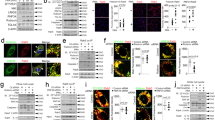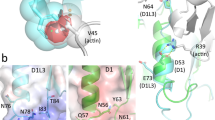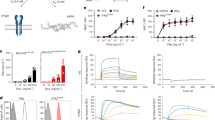Abstract
Fas ligand (CD95L) is synthesized both on the cell surface membrane and in a soluble form. Although CD95L contributes to immune privilege in the cornea and testis, the functions of these alternatively processed proteins are not well understood. Some reports suggest that the cytotoxicity of soluble CD95L is insignificant, whereas others show potent responses in vivo, including hepatocyte apoptosis that causes liver failure. We show here that extracellular matrix proteins interact with soluble CD95L and potentiate its pro-apoptotic activity. The cytotoxicity of supernatants from CD95L-expressing cells was increased by incubation on tissue culture plates coated with these matrix proteins; this effect was mediated by trimeric soluble CD95L. With the use of immunoprecipitation, it was found that CD95L binds directly to fibronectin. In addition, immunohistochemical analysis of the cornea revealed that soluble CD95L binds primarily to extracellular matrix. The retention of soluble CD95L on extracellular matrices is likely to play an important role in the development of peripheral tolerance in immune-privileged sites.
This is a preview of subscription content, access via your institution
Access options
Subscribe to this journal
Receive 12 print issues and online access
$209.00 per year
only $17.42 per issue
Buy this article
- Purchase on Springer Link
- Instant access to full article PDF
Prices may be subject to local taxes which are calculated during checkout




Similar content being viewed by others
References
Itoh, N. et al. The polypeptide encoded by the cDNA for human cell surface antigen Fas can mediate apoptosis. Cell 66, 233–243 (1991).
Suda, T., Takahashi, T., Golstein, P. & Nagata, S. Molecular cloning and expression of the Fas ligand, a novel member of the tumor necrosis factor family. Cell 75, 1169–1178 (1993).
Brunner, T. et al. Cell-autonomous Fas (CD95)/Fas-ligand interaction mediates activation-induced apoptosis in T-cell hybridomas. Nature 373, 441–444 (1995).
Dhein, J., Walczak, H., Baumler, C., Debatin, K.-M. & Krammer, P. H. Autocrine T-cell suicide mediated by APO-1/(Fas/CD95). Nature 373, 438–441 (1995).
Nagata, S. & Golstein, P. The Fas death factor. Science 267, 1449–1456 (1995).
Ju, S. et al. Fas(CD95)/FasL interactions required for programmed cell death after T-cell activation. Nature 373, 444–448 (1995).
Arai, H., Chan, S. Y., Bishop, D. K. & Nabel, G. J. Inhibition of the alloantibody response by CD95 ligand. Nature Med. 3, 843–848 (1997).
Griffith, T. S., Brunner, T., Fletcher, S. M., Green, D. R. & Ferguson, T. A. Fas ligand-induced apoptosis as a mechanism of immune privilege. Science 270, 1189–1192 (1995).
Bellgrau, D. et al. A role for CD95 ligand in preventing graft rejection. Nature 377, 630–632 (1995).
Strand, S. et al. Lymphocyte apoptosis induced by CD95/(APO-1/Fas) ligand-expressing tumor cells - a mechanism of immune evasion? Nature Med. 2, 1361–1366 (1996).
Hahne, M. et al. Melanoma cell expression of Fas(Apo-1/CD95) ligand: implications for tumor immune escape. Science 274, 1363–1366 (1996).
Lau, H. T., Yu, M., Fontana, A. & Stoeckert, C. J. Jr Prevention of islet allograft rejection with engineered myoblasts expressing FasL in mice. Science 273, 109–112 (1996).
Tanaka, M., Suda, T., Takahashi, T. & Nagata, S. Expression of the functional soluble form of human Fas ligand in activated lymphocytes. EMBO J. 14, 1129–1135 (1995).
Kayagaki, N. et al. Metalloproteinase-mediated release of human Fas ligand. J. Exp. Med. 182, 1777–1783 (1995).
Tanaka, M., Itai, T., Adachi, M. & Nagata, S. Downregulation of Fas ligand by shedding. Nature Med. 4, 31–36 (1998).
Schneider, P. et al. Conversion of membrane-bound Fas (CD95) ligand to its soluble form is associated with downregulation of its proapoptotic activity and loss of liver toxicity. J. Exp. Med. 187, 1205–1213 (1998).
Tanaka, M. et al. Fas ligand in human serum. Nature Med. 2, 317–322 (1996).
Rensing-Ehl, A. et al. Local Fas/APO-1 (CD95) ligand-mediated tumor cell killing in vivo. Eur. J. Immunol. 25, 2253–2258 (1995).
Tanaka, M., Suda, T., Yatomi, T., Nakamura, N. & Nagata, S. Lethal effect of recombinant human Fas ligand in mice pretreated with propionibacterium acnes. J. Immunology 158, 2303–2309 (1997).
Peitsch, M. C. & Tschopp, J. Comparative molecular modelling of the Fas-ligand and other members of the TNF family. Mol. Immunol. 32, 761–772 (1995).
Schneider, P. et al. Characterization of Fas (Apo-1, CD95)-Fas ligand interaction. J. Biol. Chem. 272, 18827–18833 (1997).
Declerck, P. J. et al. Purification and characterization of a plasminogen activator inhibitor 1 binding protein from human plasma. J. Biol. Chem. 263, 15454–15461 (1988).
Lawrence, D., Strandberg, L., Grundstrom, T. & Ny, T. Purification of active human plasminogen activator inhibitor 1 from E. coli. Eur. J. Biochem. 186, 523–533 (1989).
Zheng, X., Saunders, T. L., Camper, S. A., Samuelson, L. C. & Ginsburg, D. Vitronectin is not essential for normal mammalian development and fertility. Proc. Natl Acad. Sci. USA 92, 12426–12430 (1995).
Erickson, L. A. et al. Development of venous occlusions in mice transgenic for the plasminogen activator inhibitor-1 gene. Nature 346, 74–76 (1990).
Carmeliet, P. et al. Plasminogen activator inhibitor-1 gene-deficient mice. J. Clin. Invest. 92, 2746–2755 (1993).
Salonen, E. et al. Interaction of Plasminogen activator inhibitor (PAI-1) with vitronectin. J. Biol. Chem. 264, 6339–6343 (1989).
Seiffert, D., Wagner, N. & Loskutoff, D. Serum-derived vitronectin influences the pericellular distribution of type 1 plasminogen activator inhibitor. J. Cell Biol. 111, 1283–1291 (1990).
Chen, J.-J., Sun, Y. & Nabel, G. J. Regulation of the proinflammatory effects of Fas ligand (CD95L). Science 282, 1714–1717 (1998).
Dick, A. D. et al. Fas-Fas Ligand-Mediated Apoptosis within Aqueous during Idiopathic Acute Anterior Uveitis. Invest. Ophthalmol. Vis. Sci. 40, 2258–2267 (1999).
Sotozono, C. et al. Soluble Fas ligand expression in the ocular fluids of uveitis patients. Curr. Eye Res. 20, 54–57 (2000).
Kayagaki, N. et al. Polymorphism of murine Fas ligand that affects the biological activity. Proc. Natl Acad. Sci. USA 94, 5986–5990 (1997).
Acknowledgements
We thank D. Gschwend, C. Davis, N. Barrett and J. Stein for manuscript preparation; L. L. Xu for the preparation of the slides for histological analysis; and members of the Nabel laboratory for their helpful advice and comments.
Author information
Authors and Affiliations
Corresponding author
Rights and permissions
About this article
Cite this article
Aoki, K., Kurooka, M., Chen, JJ. et al. Extracellular matrix interacts with soluble CD95L: Retention and enhancement of cytotoxicity. Nat Immunol 2, 333–337 (2001). https://doi.org/10.1038/86336
Received:
Accepted:
Issue Date:
DOI: https://doi.org/10.1038/86336
This article is cited by
-
Novel strategies to mimic transmembrane tumor necrosis factor-dependent activation of tumor necrosis factor receptor 2
Scientific Reports (2017)
-
CD95 and CD95L promote and protect cancer stem cells
Nature Communications (2014)
-
T-cell death and cancer immune tolerance
Cell Death & Differentiation (2008)
-
Membrane-bound CD95 ligand expressed on human antigen-presenting cells prevents alloantigen-specific T cell response without impairment of viral and third-party T cell immunity
Cell Death & Differentiation (2007)
-
Mother's little helpers: mechanisms of maternal-fetal tolerance
Nature Immunology (2006)



